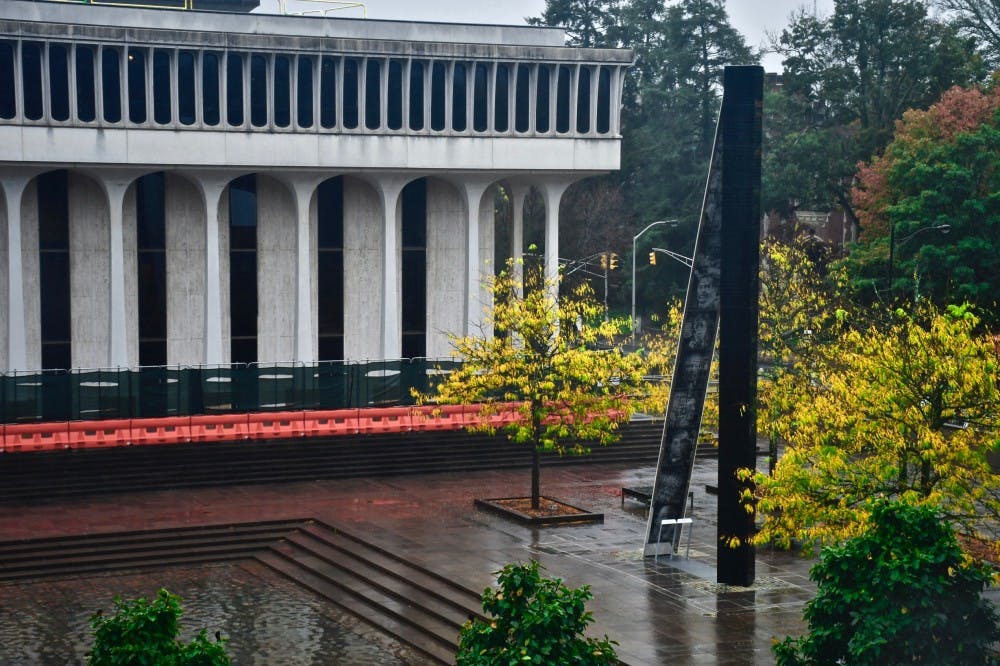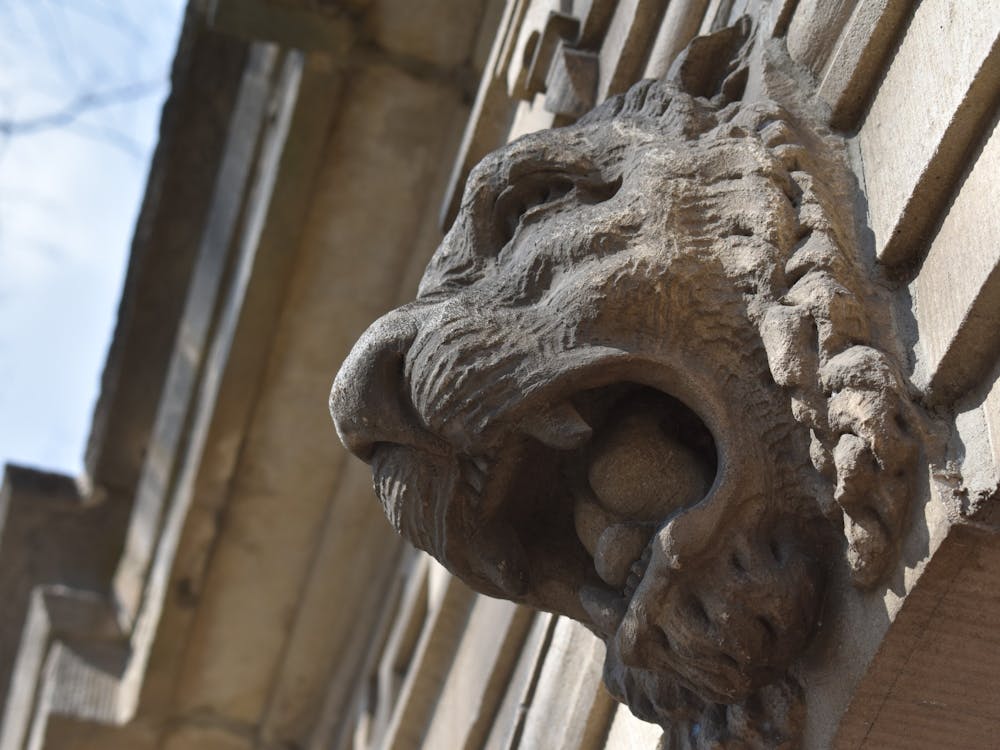Tomorrow the University will unveil a new marker on campus about Woodrow Wilson called “Double Sights.” In the meantime, inside the school that bears Wilson’s name, students are waiting for the administration to fulfill its commitment to diversity and inclusion. This is not a time to celebrate; when viewed in the proper context, the marker emerges as a monument to the University’s moral failure in dealing with Wilson’s legacy and should be seen accordingly.
Three years ago, the Trustee Committee on Woodrow Wilson’s Legacy at Princeton — “the Committee” — published its final report, a response to a list of demands from a student group called the Black Justice League, which included a demand that Wilson’s name be removed from the school. The Committee’s report included a number of recommendations, one of which was to “install a permanent marker on-site that educates the campus community and others about both the positive and negative dimensions of Wilson’s legacy.” The Committee recommended that Wilson’s name remain.
When you read the students’ demands and the trustees’ report and apply some of the analytical skills that are taught at the Wilson School, both the argument to keep Wilson’s name and the University’s slow, modest responses to students’ demands — such as the marker — come into full view as illogical and inadequate.
As policy students, we are taught that program evaluations must be conducted by independent institutions and that individuals and organizations notoriously lack the ability to critically analyze their own performance. The Committee was comprised of 10 accomplished people, nine of whom attended Princeton — with an average of 40 years since graduation — and serve on various University boards and committees. There was one person with no apparent connection to the University. Ninety percent of the people involved had a vested interest in maintaining the school’s prestige, reputation, and ranking. In the classrooms of the Wilson School, this is known as systematic bias. In fact, one professor at the Wilson School has a name for the outcomes of such processes: magical thinking.
Furthermore, trustee members are generally highly compensated with the social capital and prestige that comes with being a trustee at one of the country’s most renowned institutions, although no one was paid for their involvement with the Committee. What, then, are the incentives to disrupt the order of things by changing the name of the Wilson School? In economic terms, the process was not incentive-compatible. To the trustees, the economic and social value of keeping the name was greater than the cost of changing it — evidenced by the final decision to keep Wilson’s name.
Another core tenet of policy evaluation taught at the Wilson School is that programs, especially if they are to be evaluated, should have a clear theory of change and an obvious logic model. What was the Committee’s logic model for leaving Wilson’s name alone?
The stated goal in the report — which we encourage everyone to read in its entirety — is to make the University a diverse, inclusive, and welcoming community. To summarize, the proposed process was to acknowledge past mistakes when talking about Wilson, invite original and critical research on Wilson, and attempt to institutionalize a more complex narrative about his legacy. In addition to activity at the Wilson school, which is addressed below, the University committed to a series of initiatives to promote diversity — including, but not limited to, an effort to recruit a diverse body of Ph.D. students, update the informal motto, which is now installed on a marker in the center of the quad in front of Nassau Hall, and modernize some of the iconography on campus, an example of which may be found by looking for the yellow QR code on the floor outside of the chapel.
The Committee also states its interest in changing the “campus climate” so that people feel that “the Princeton they attend is their Princeton,” and that keeping Wilson’s name on the school implies no endorsement of views and actions that conflict with the values and aspirations of our times.

Herein lies more magical thinking. Surely the trustees understand that the symbolic power of Wilson’s name on the marquee in the world-famous Princeton orange is the ultimate endorsement. Naming at the University is reserved for only the most revered; there isn’t a bigger honor bestowed by the institution. However, the policy school remains the only named undergraduate- or graduate-level school at the University.
Reading the report three years after it was released, it isn’t believable that the Committee genuinely expects students of color to feel that the Princeton they attend is “their Princeton” when the name of a man who would not admit them — the same man who hosted the KKK at the White House — adorns the letterhead. Campus culture is set at the top. The name change was a chance for the trustees to say: follow us. They chose to do the opposite.
What, then, do we make of the marker as a method of dealing with Wilson’s legacy?
It is highly unlikely that this marker will promote the level of dialogue the Committee articulated as a goal in their report. The Committee committed to “complicating” Wilson’s legacy and putting that more complex legacy at the forefront, but it is unclear the degree to which students are engaging with this more complex narrative.

For example, last week, a student in the Wilson School conducted a short, unscientific poll. Of the 28 students standing in the hallway of Robertson Hall, directly in front of an exhibit about Woodrow Wilson, 15 said that they had never read the content. Across campus, only 10 out of 47 people said that they had read the installation at the front of the Betsey Stockton Garden — named for a highly accomplished woman who began her life as a slave of Rev. Ashbel Green, a former University president.
The design by Walter Hood is striking and Hood has engaged thoughtfully with students on the marker, but the work to make the Wilson School more inclusive and diverse won’t come from a tall installation. Any progress from the last three years is a result of the work of people — not inanimate objects. The school is very obviously trying to promote diversity, equity, and inclusion.
There has been progress in response to renewed student outcries after the publication of the Committee’s report: the University has institutionalized a Diversity and Inclusion Standing Committee; there is a visiting research scholar for diversity and inclusion; students have optional training on issues related to diversity and inclusion. By many accounts, the experience of this year’s MPA1 class has been better than last year’s and by its own accounting this year’s graduate class is the most diverse in the University’s history.
Progress on diversity, however, should not be a distraction from the work to be done on equity or making the school a truly inclusive one; the scope of work is too narrow and the rate of change is far too slow. For a school that prides itself on excellence, the University fails to stack up to other institutions on this aspect of the professional training. It is equally important to understand how to address structures of power and race as it is to design and run an RCT or assess the labor market implications of artificial intelligence. As currently constructed, the current programs are graduating policy leaders who lack the knowledge and skills required to be truly effective in today’s policy environment and the institutions of the future.
Students understand who this place is for, and chances are that you believe it’s for you if you are more like Woodrow Wilson than Betsey Stockton. Despite what the report claims about the marker, it seems that this entire years-long exercise — including the decision to keep the name — is about keeping the University as it is, or changing it as little as possible, and then trying to insulate that position from criticism by dressing it up in committees, reports, and campus installations.
As students and alumni, it is our responsibility to remind the campus community that the events on Saturday are a distraction. When you pass that marker, understand that it represents two things: moral failure of the University and how much work remains.
Aaron Charlop-Powers is a Master’s in Public Policy student at the Wilson School. He is originally from the Bronx and can be reached at aaronsc@princeton.edu.
The following graduate students, all of the Wilson School, added their names in support of this piece.
Mark Lee, MPA 2021
Samantha Adelberg, MPA 2018
Spogmay Ahmed, MPA 2020
Emily Andrews, MPP 2020
Emily Apple, MPA 2020
Maya Aronoff, MPA 2023 (SINSI)
Nathan Babb, MPA 2021
Ana Billingsley, MPA 2019
Alessandra Brown, MPA 2018
Chloe Brown, MPA 2018
Molly Brune, MPA 2021
Aaron Charlop-Powers, MPP 2020
Shehab Chowdhury, MPA 2018
Lauren Clark, MPA 2021
Edwin Coleman, MPA 2019
Ileana Cruz-Marden, MPA 2019
Julieta Cuéllar, MPA 2019
JR DeLaRosa, MPP 2020
Francisco Diez, MPA 2020
Isabel DoCampo, MPA 2019
Riley Edwards, MPA 2021
Joelle Gamble, MPA 2019
Varsha Gandikota, MPA 2019
Wendy Gomez, MPA 2021
Rebecca Gorin, MPA 2021
Maya Hardimon, MPA 2021
Hope Jackson, MPA 2020
Lauren Knight, MPP 2020
Paulina Lopez Gonzalez, MPA 2019
Juliana Macedo do Nascimento, MPP 2019
Stefanie Mavronis, MPA 2018
Jenna Mellor, MPA 2020
Alex Merchant, MPA 2021
Leyla Mocan, MPA 2019
Maria Moscoso, MPA 2021
Michelle Nedashkovskaya, MPA 2020
Taylor Nelson, MPA 2019
Jasmine Pineda, MPA 2021
Sujata Rajpurohit, MPA 2021
Rocio Rodarte, MPA 2020
Jessica Sarriot, MPA 2018
Fionnuala Seiferth, MPA 2020
Nathaniel Tek, MPP 2020
Emily Tenenbom, MPA 2021
Maggie Tennis, MPA 2021
Solomon Tesfaye, MPA 2020
Anh Ton, MPA 2020
Arturo Trejo, MPP 2020
Kayla Vinson, MPA/JD 2019
Clarke Wheeler, MPA 2021
Amy Williams Navarro, MPA 2020
Laura Williamson, MPA 2018
Lindsay Wylie, MPA 2020
Amber Zuberi, MPA 2018
Mark Lee, MPA 2021








